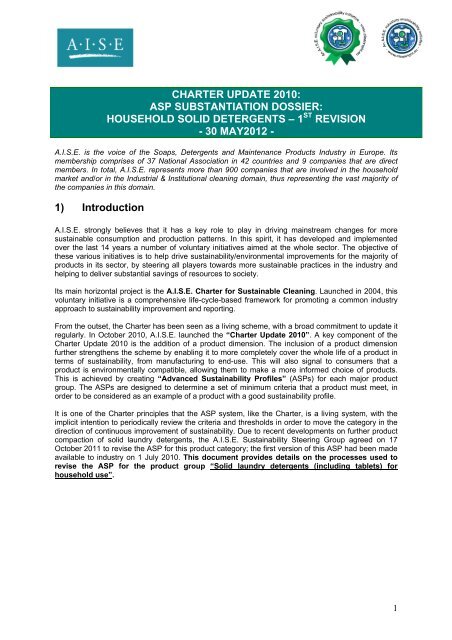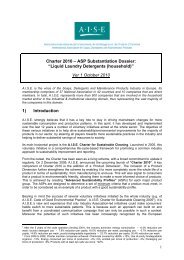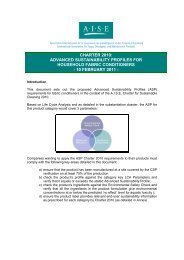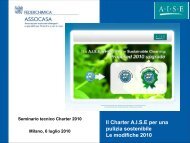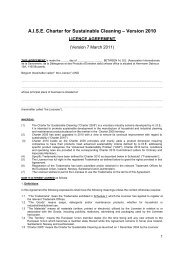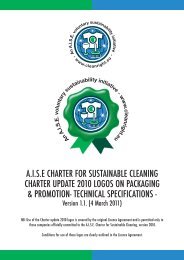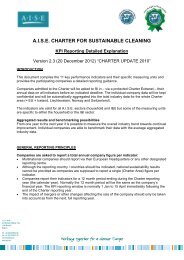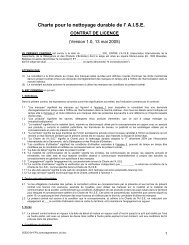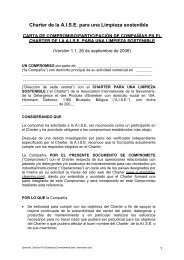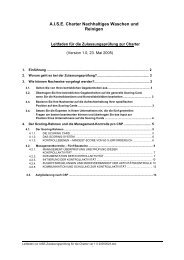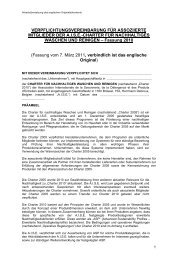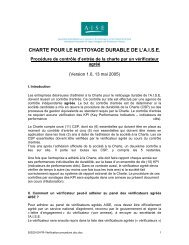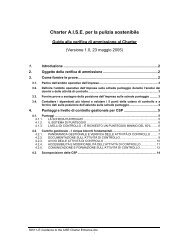2. Substantiation dossier - Sustainable Cleaning
2. Substantiation dossier - Sustainable Cleaning
2. Substantiation dossier - Sustainable Cleaning
Create successful ePaper yourself
Turn your PDF publications into a flip-book with our unique Google optimized e-Paper software.
CHARTER UPDATE 2010:<br />
ASP SUBSTANTIATION DOSSIER:<br />
HOUSEHOLD SOLID DETERGENTS – 1 ST REVISION<br />
- 30 MAY2012 -<br />
A.I.S.E. is the voice of the Soaps, Detergents and Maintenance Products Industry in Europe. Its<br />
membership comprises of 37 National Association in 42 countries and 9 companies that are direct<br />
members. In total, A.I.S.E. represents more than 900 companies that are involved in the household<br />
market and/or in the Industrial & Institutional cleaning domain, thus representing the vast majority of<br />
the companies in this domain.<br />
1) Introduction<br />
A.I.S.E. strongly believes that it has a key role to play in driving mainstream changes for more<br />
sustainable consumption and production patterns. In this spirit, it has developed and implemented<br />
over the last 14 years a number of voluntary initiatives aimed at the whole sector. The objective of<br />
these various initiatives is to help drive sustainability/environmental improvements for the majority of<br />
products in its sector, by steering all players towards more sustainable practices in the industry and<br />
helping to deliver substantial savings of resources to society.<br />
Its main horizontal project is the A.I.S.E. Charter for <strong>Sustainable</strong> <strong>Cleaning</strong>. Launched in 2004, this<br />
voluntary initiative is a comprehensive life-cycle-based framework for promoting a common industry<br />
approach to sustainability improvement and reporting.<br />
From the outset, the Charter has been seen as a living scheme, with a broad commitment to update it<br />
regularly. In October 2010, A.I.S.E. launched the “Charter Update 2010”. A key component of the<br />
Charter Update 2010 is the addition of a product dimension. The inclusion of a product dimension<br />
further strengthens the scheme by enabling it to more completely cover the whole life of a product in<br />
terms of sustainability, from manufacturing to end-use. This will also signal to consumers that a<br />
product is environmentally compatible, allowing them to make a more informed choice of products.<br />
This is achieved by creating “Advanced Sustainability Profiles” (ASPs) for each major product<br />
group. The ASPs are designed to determine a set of minimum criteria that a product must meet, in<br />
order to be considered as an example of a product with a good sustainability profile.<br />
It is one of the Charter principles that the ASP system, like the Charter, is a living system, with the<br />
implicit intention to periodically review the criteria and thresholds in order to move the category in the<br />
direction of continuous improvement of sustainability. Due to recent developments on further product<br />
compaction of solid laundry detergents, the A.I.S.E. Sustainability Steering Group agreed on 17<br />
October 2011 to revise the ASP for this product category; the first version of this ASP had been made<br />
available to industry on 1 July 2010. This document provides details on the processes used to<br />
revise the ASP for the product group “Solid laundry detergents (including tablets) for<br />
household use”.<br />
1
2) The market (EU, plus Norway and Switzerland)<br />
Fabric Washing:<br />
=> 51 % of A.I.S.E. total household market<br />
value; the industry’s biggest market in<br />
Europe.<br />
=> Market Value: 14.5 billion Euros in 2010<br />
Estimated proportion for the value of solid<br />
laundry detergents: about 35 % i.e. about<br />
5.0 billion Euros.<br />
(Source: Euromonitor International)<br />
Source: A.I.S.E. Activity and Sustainability<br />
Report 2010-2011<br />
3) ASP principles<br />
The principles applied to the setting of the ASP criteria are as follows:<br />
1. The ASP criteria should represent a target that is aspirational, but reasonably achievable<br />
by all using readily available technology. Our vision is that the product within the category<br />
should be able to achieve the ASP targets within a reasonable timeframe.<br />
<strong>2.</strong> The ASP criteria reflect as completely as possible the key drivers of reduced environmental<br />
impact (hot spots), as identified by Life Cycle Analysis (LCA).<br />
3. The Advanced Sustainability Profile, like the Charter, is a living system, with the implicit<br />
intention to periodically review the criteria and thresholds in order to move the category in the<br />
direction of continuous improvement of sustainability.<br />
4. The setting of ASP criteria must always follow the established evaluation and consultation<br />
process, as detailed in the next section.<br />
2
4) Process for the development of the ASP for solid laundry detergents<br />
1. Identification of product category and installation of A.I.S.E. Task Force<br />
The A.I.S.E. Sustainability Steering Group (SSG) proposed on 17 October 2011 to revise the<br />
ASP for solid laundry detergents. The ASP Task Force which was set up to revise such ASP,<br />
met for the first time on 28 November 2011. It was composed of experts from six companies,<br />
namely Danlind, Henkel, McBride, Mifa, P&G, and Unilever. Work was coordinated by the<br />
A.I.S.E. Secretariat.<br />
The ASP for solid laundry detergents has been originally developed in relation to the Laundry<br />
Sustainability Project 2 (LSP2) on compaction which set a maximum recommended dosage of<br />
85g/135 ml per wash (see www.aise.eu/lsps). LSP2 is coming to an end on 31 March 201<strong>2.</strong><br />
Building on its environmental achievements (15 companies participated in the project),<br />
A.I.S.E. is launching a new compaction project, the Product Resource Efficiency Project<br />
(PREP-P3) which will recommend a maximum recommended dosage of 75g/115 ml per<br />
wash. The project will be open for commitment on 1 July 2012 and companies will be allowed<br />
to place on the market their “PREP-P3 labeled” products as from 1 July 2013.<br />
In view of the close relation between the ASP and the LSPs/PREPs, it becomes necessary to<br />
revise the ASP – product formulation criteria in parallel. Given the work carried out on the<br />
product formulation criteria it was also decided to revise the overall packaging weight criteria.<br />
<strong>2.</strong> Development by the Task Force of ASP criteria and thresholds<br />
Based on an existing generic Life Cycle Analysis [LCA] (see chapter 5) the TF identified<br />
relevant LCA parameters. It also made use of the work done in parallel for the “Product<br />
Resource Efficiency Project” PREP-P3 initiative, namely the selection of a threshold for<br />
dosage based on an industry consultation which confirmed its technical feasibility.<br />
Concerning a threshold for packaging, a consultation was organised by the A.I.S.E.<br />
Secretariat in January/February 201<strong>2.</strong> Four companies represented in the TF provided input<br />
on a representative sample of the EU market.<br />
3. Internal A.I.S.E. consultation and endorsement<br />
This recommendation on the ASPs and thresholds was presented for approval to the SSG on<br />
17 February 2012, the A.I.S.E. Legal Panel via email consultation between 15 March and 4<br />
April 2012 and the A.I.S.E. Board on 26 April 201<strong>2.</strong> In addition this <strong>dossier</strong> was developed in<br />
order to substantiate in a transparent way the processes and the proposed thresholds.<br />
4. Industry consultation and activation<br />
The ASPs and the substantiation <strong>dossier</strong> were subject to consultation with Charter member<br />
companies and the industry from 27 April till 21 May 201<strong>2.</strong> Companies were asked to<br />
comment/input on the relevance and technical feasibility of the proposed thresholds.<br />
Based on the received input, these ASPs were finalised as part of the Charter and are made<br />
available to industry from 1 July 201<strong>2.</strong><br />
3
5) ASP criteria and rationale<br />
A generic Life Cycle Analysis (LCA) on solid laundry detergents was carried out before the Charter<br />
ASP targets were set, to get an understanding of the environmental impacts of the various stages of a<br />
detergent’s life cycle.<br />
NB: Work on an updated screening LCA has been initiated; this is currently been carried out<br />
by the consultancy PRé and will be included here as soon as it is available. However, taking<br />
into account existing company LCAs for this product category, LCA experts from the A.I.S.E.<br />
network expect that the overall outcome will not differ much from that of the LCA to which it is<br />
referred below and which had been used for the development of the 1 st ASP version.<br />
The stages of the process considered were:<br />
- ingredients extraction / production<br />
- powder production<br />
- packaging<br />
- distribution<br />
- use<br />
- disposal<br />
and the parameters evaluated were:<br />
- energy consumption<br />
- water emissions<br />
- solid waste produced.<br />
The analysis confirms that the three most important factors in Life Cycle Analysis for solid laundry<br />
detergents are as follows:<br />
1. The most significant impact on the environment is in the use and disposal phases of the<br />
product’s life, due to the significant amounts of energy and water consumed by the washing<br />
machine. Therefore any LCA based criteria must take usage into account.<br />
<strong>2.</strong> The second most important factor to reduce environmental impact is through the reduction in<br />
resources used to manufacture the product. By concentrating or compacting solid laundry<br />
detergents, chemical use is reduced and this delivers significant savings in energy (hence<br />
CO 2 ) and waste, as well as delivering substantial savings in freight as more product can be<br />
carried on one truck.<br />
3. Given that laundry detergents end up as water-borne waste, it is essential that a sustainable<br />
product poses no risk for the environment. Therefore, all “down-the-drain” product categories<br />
must pass the Environmental Safety Check (ESC).<br />
Using the above life-cycle analysis as a starting point, the A.I.S.E. Task Force in charge of setting the<br />
ASP criteria for solid laundry detergents confirmed the relevance of the following main components,<br />
which had been considered when the 1 st version of ASP for solid laundry detergents was developed:<br />
- activities at product level, under the direct control of manufacturers:<br />
- by determining a maximum dosage of ingredients per standard wash<br />
- by determining a maximum dosage of packaging materials per standard wash<br />
- by setting a minimum level of recycled content in primary and secondary packaging.<br />
- by allowing low temperature wash (≤ 30°C)<br />
- activities at consumer level given that this represents the highest environmental impact:<br />
4
- providing on-pack guidance for the most sustainable product use (e.g. low temperature<br />
washing)<br />
Implicit in the ASP criteria is that a product must deliver an acceptable level of performance at low<br />
washing temperatures (≤ 30°C).<br />
In order for a product to meet the ASP, it must meet the conditions in each and every domain as<br />
detailed below:<br />
5
ASP criteria for household Solid Laundry Detergents (including tablets)<br />
The following requirements in each of these domains (i.e. product formulation, packaging<br />
and end-use information) should be fulfilled in order to reach Advanced Sustainability Profile<br />
(ASP) status.<br />
Product formulation<br />
Overall packaging weight<br />
Board packaging –<br />
recycled content<br />
Pass successfully Environmental Safety Check (ESC) on<br />
all ingredients<br />
AND<br />
Dosage g/job:<br />
≤ 75 g<br />
AND<br />
Dosage ml/job:<br />
≤ 115 ml<br />
Total (primary + secondary but excluding tertiary)<br />
packaging g/job:<br />
≤ 6.5 g<br />
Minimum requirement: ≥ 60 %<br />
OR<br />
Where 100% of the board used is certified made from<br />
fibre sourced from sustainable forests under an<br />
endorsed certification standard such as FSC, SFI or<br />
PEFC: no minimum.<br />
Materials other than board –<br />
recycled content<br />
Wash temperature<br />
End User Information<br />
Performance<br />
No minimum, but any recycled plastic content may be<br />
excluded from the calculation of overall packaging<br />
weight per job<br />
Ability to wash at ≤ 30° C indicated on pack<br />
End-user info on-pack:<br />
Laundry Cleanright (former Washright) Panel<br />
(see Annex of ASP criteria document)<br />
Safe Use tips<br />
Evidence has to be provided (in case of external<br />
verification organised by A.I.S.E.) that the product has<br />
been performance tested and reached a level<br />
acceptable to consumers consistent with claims made.<br />
6
Clarifications/Definitions:<br />
Job: following the Detergent Regulation EC 648/2004 the “standard washing machine loads are 4,5<br />
kg dry fabric for heavy-duty detergents and 2,5 kg dry fabric for low-duty detergents”.<br />
Ingredients per job/ heavy-duty detergents: based on medium water hardness and normally soiled<br />
fabric<br />
Ingredients per job/ low-duty detergents: based on medium water hardness and lightly soiled fabric<br />
Packaging weight per job: Total (primary + secondary) packaging (g/job) - based on the volume<br />
weighted average for all SKUs of one brand variant with the same formulation per country. Variants of<br />
the brand which do not pass all other ASP category tests and/or are not intended to carry the ASP<br />
logo must be excluded from the calculation. Dosage devices – apart from closures – are not to be<br />
considered as packaging.<br />
Primary/secondary/tertiary packaging: following definitions from the European Parliament and Council<br />
Directive 94/62/EC of 20 December 1994 on packaging and packaging waste:<br />
- primary packaging, i. e. packaging conceived so as to constitute a sales unit to the final<br />
user or consumer at the point of purchase;<br />
- secondary packaging, i. e. packaging conceived so as to constitute at the point of<br />
purchase a grouping of a certain number of sales units whether the latter is sold as such<br />
to the final user or consumer or whether it serves only as a means to replenish the<br />
shelves at the point of sale; it can be removed from the product without affecting its<br />
characteristics; SRB (shelf ready box) and AB (American box) are to be considered as<br />
secondary packaging.<br />
- tertiary packaging, i. e. packaging conceived so as to facilitate handling and transport of a<br />
number of sales units or grouped packagings in order to prevent physical handling and<br />
transport damage.<br />
Note: Packaging which functions both as secondary (case) and tertiary (transportation unit)<br />
packaging, intended to function as an in-store free-standing floor display unit, is regarded as tertiary<br />
packaging for the purpose of this definition.<br />
Packaging re-cycled content: in countries where re-cycled board is not available and a use of it would<br />
be a disadvantage for sustainable reasons, the use of re-cycled board is not required.<br />
Recycled: waste recycled after use<br />
FSC: Forest Stewardship Council<br />
SFI: <strong>Sustainable</strong> Forestry Initiative<br />
PEFC: Programme for the Endorsement of Forest Certification<br />
7
Product formulation<br />
Based on the outcome of the Life Cycle Analysis, the LCA experts identified the concentration of a<br />
product as one of the key factors, in order to reduce the environmental impact. Recognising that there<br />
is an opportunity to continue to extend the sustainability benefits with regard to the product<br />
formulation, the A.I.S.E. Sustainability Steering Group agreed that it would be appropriate to take<br />
another step towards. Building on the first Charter ASP for solid laundry detergents, which had been<br />
launched in July 2010 and for which a threshold for dosage had been set at 85g/135 ml, it is industry<br />
experts’ opinion, that a dosage of 75g/115ml appears now to be as setting a right balance between<br />
the aim to reach environmental savings and the possibility to achieve it through conventional<br />
technology available to all companies, including SMEs. The relevance of 75g/115ml per wash<br />
threshold was confirmed as one outcome of the consultation.<br />
Packaging<br />
Taking into account the outcome of the life-cycle analysis, packaging was identified as a further key<br />
factor, in order to reduce the environmental impact. In proportion to the decreased dosage threshold,<br />
a threshold of 6.5g for overall packaging per job has been proposed by industry experts. The<br />
threshold of 6.5 g per wash was confirmed as one outcome of the consultation.<br />
Packaging recycled / sustainably sourced content<br />
With regard to recycled content in packaging, a threshold of 60 % has been identified as still<br />
achievable by manufacturing companies, using conventional technologies yet leading to<br />
environmental benefit.<br />
As a further consultation outcome, a second option was added in order to fulfil this ASP criteria: the<br />
complete amount of packaging virgin board has to come from fibre sourced in a managed way, using<br />
certified forest content from an endorsed certification standard such as FSC, SFI or PEFC (FSC:<br />
Forest Stewardship Council; SFI: <strong>Sustainable</strong> Forestry Initiative; PEFC: Programme for the<br />
Endorsement of Forest Certification).<br />
End user Information<br />
As figured out in the life-cycle analysis, the most significant impact on the environment is in the use<br />
and disposal phases of the product’s life, due to the significant amounts of energy and water<br />
consumed by the washing machine.<br />
In April 2011, A.I.S.E. commissioned a consumer survey across more than 5,000 consumers in 23<br />
different countries about their current washing habits (a similar survey was run at the end of 2008).<br />
This survey showed that there is still significant progress to be achieved in the way consumers wash.<br />
For instance:<br />
- Only 56% of washing machine loads are full (compared to 49% in 2008).<br />
- The average wash temperature is 41.0°C (compared to 4<strong>2.</strong>6°C in 2008).<br />
- 32% of loads are washed at 30°C or lower (compared to 29% in 2008).<br />
- Only 69% of consumers indicate that they are aware of the dosing instructions (compared to 76% in<br />
2008).<br />
Considerable savings, both environmentally (water, energy, CO2, chemicals), and economic<br />
(financial savings for consumers due to correct dosing and efficient use of the appliance), could be<br />
reached through better sustainable consumer behaviour. In addition to formulating products that are<br />
compact and efficient at low temperature, it is also key to continue providing the consumers advice<br />
about wash parameters and correct dosage. Within this revised ASP criteria framework, companies<br />
are also be requested to use the Laundry Cleanright (former Washright) Panel, which had been<br />
introduced by A.I.S.E. in 1998 and revised in 2008 (see details in annex 2 of advanced sustainability<br />
profiles), and to indicate the ability to wash at ≤ 30° C on pack. Evidence has to be provided that the<br />
product has been performance tested and reached a level acceptable to consumers consistent with<br />
claims made. This was confirmed in the consultation.<br />
8
6) Value of industry self-regulation<br />
A.I.S.E. has a long tradition of successful voluntary initiatives initiated for the whole industry (e.g.<br />
A.I.S.E. Code of Good Environmental Practice, A.I.S.E. Charter for <strong>Sustainable</strong> <strong>Cleaning</strong>, version<br />
2005, Laundry Sustainability Projects), which have all achieved significant savings. 1<br />
It is A.I.S.E.’s view and experience that in these specific circumstances, industry association-led<br />
initiatives are more reliable than “business as usual”/individual company led initiatives for the following<br />
reasons:<br />
- Detergent concentration: By raising the industry standards to the proposed levels of<br />
concentrations, this will help move the whole market to such standards in a self-regulatory way,<br />
as successfully as regulation whilst leaving innovation potential for companies.<br />
- Environmental Safety; the ESC tool offers a common set of data that the whole industry can have<br />
access to, and against which they can benchmark their formulation; this offers a common level<br />
playing field for all market players in a free, public way that is also transparent to all stakeholders.<br />
- Optimal use of products: Common industry communication to drive sustainable consumption, in<br />
line with other A.I.S.E activities such as the Washright campaign for laundry make a lot of sense,<br />
and also have the value of potentially being further relayed to the public by other stakeholders<br />
especially if they are industry led. This is because such an approach can build on and benefit<br />
from a coordinated communication campaign with consistent messages that can only be possible<br />
in such a context.<br />
Moreover the potential of such initiatives has been increasingly recognized by the European<br />
Commission to the point that it has been explicitly addressed in the SCP/SIP Action Plan.<br />
1<br />
After the 5 years of the “Code” initiative (ending 2001), the industry achieved: energy consumption – 6.4 % reduction per<br />
wash; laundry detergent use – 7.9 % reduction per capita, 16.0 % reduction per wash; packaging use – 6.7 % reduction per<br />
capita, 14.9 % reduction per wash; poorly biodegradable ingredients – 23.7 % reduction per capita, 30.4 % reduction per<br />
wash.<br />
From 2006 to 2010, Charter member companies achieved: Chemicals covered by HERA: +10 %; Energy consumed per tonne<br />
of production: -13 %; CO 2 emitted per tonne of production: -14.3 %; Waste: -7.5 %; Water: -<strong>2.</strong>8 %; Products with at least two<br />
safe use icons: +129 %.<br />
9
7) Expected benefits<br />
With the implementation of the Advanced Sustainability Profile for solid laundry detergents the<br />
following benefits are expected EU wide:<br />
<br />
<br />
<br />
<br />
Reassurance that ingredients in the product formulation have an environmental concentration<br />
at or below the predicted no-effect level for aquatic toxicity<br />
Optimal use of ingredients due to product compaction/concentration:<br />
→ Expected benefits: 116,000 tonnes of ingredients 2<br />
Optimal use of packaging due to product compaction/concentration:<br />
→ Expected benefits: 8,300 tonnes of packaging material.<br />
Optimisation on transport<br />
→ Expected benefits: About 5,900 truck journeys due to reduction of product volume<br />
8) Timing<br />
<br />
<br />
<br />
<br />
<br />
<br />
<br />
From 27 April till 21 May 2012: Industry consultations on revised ASP for solid laundry<br />
detergents<br />
By 8 June 2012: Finalisation of revised ASP documentation<br />
By 1 July 2012: Availability of revised ASP to the industry<br />
1 July 2012 till 30 June 2013: Preparation period for implementation of revised ASP<br />
As from 1 July 2013: Activation – products complying with revised ASP requirements for solid<br />
laundry detergents can start to appear on shelves with ASP logo<br />
In parallel a closing down period of 6 months (1 July - 31 December 2013) will ensure<br />
transition between “old” (issued in July 2010) and “revised” ASP. Within this period<br />
companies shall stop producing “old ASP products”.<br />
By 30 June 2014 companies will no longer place “old ASP products” on the market.<br />
2<br />
In the context of the aforementioned A.I.S.E. PREP-P3 project, an LCA Expert Working Group has developed a preliminary<br />
evaluation based on the hypothesis of compacting and concentrating the current “regular” powder detergents to a level that<br />
would allow obtaining a performance equivalent to today’s products with dosages which are not greater than 75 g/wash and<br />
115 ml/wash.<br />
10


